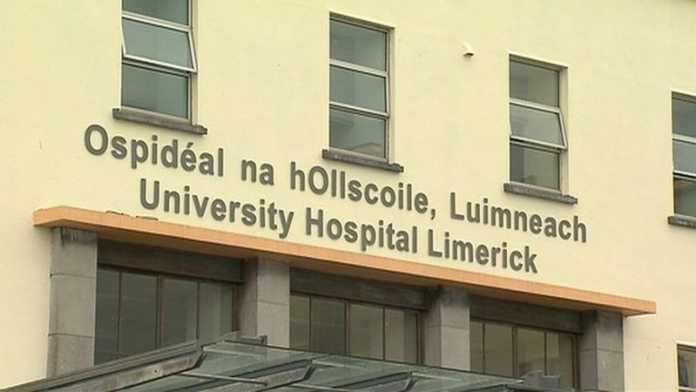
UNIVERSITY Hospital Limerick (UHL) had the highest number of people on trollies in the country on June 6, and the highest nationally in May, according to the Irish Nurses and Midwives Organisation (INMO) trolley and ward watch figures.
INMO figures for the month of May, compared with previous years, records the highest figure ever for the month, with 9,091 patients awaiting on in-patient bed and UHL – 858 and Cork University Hospital – 826 were the two highest recorded in May.
These figures show an overall increase of 12 per cent on the same period last year, May 2017 when there were 8,154 admitted patients awaiting a bed and a 116 per cent increase from May 2006 when there were 4,214 patients on trolleys.
INMO General Secretary, Phil Ni Sheaghdha said, “INMO are seeking a total re-look at the national planning process and particularly The Winter Initiative, as solutions to this constant and worsening crisis cannot wait for funding injection in late November or January when the escalating problems are out of control.
“We live in a society which expects a long wait, and a lack of privacy and dignity when attending EDs. It is not acceptable. It is a basic human right that a person deemed as requiring hospital admission is admitted to a suitable bed which is appropriately staffed”.
“Complacency must be replaced with proactive planning, aimed at correcting, not simply reducing, the numbers to make it look somewhat better. In line with the HIQA recommendations of 2012, the aim must be: patients never have to experience care on corridors and inappropriate spaces in EDs. These HIQA recommendations are like a fairy-tale, considering the worsening problems with overcrowding since its report”.
Spokesperson for the Still Waiting Health Campaign Cyril Brennan said, “People are still waiting for an increase in capacity within our health service, which was promised by successive governments since 2000”.
The response from the UL Hospital Group said:
“The Emergency Department at UHL is one of the busiest in the country with over 67,800 attendances last year, an increase of 5% on the previous year. The numbers requiring admission includes many frail elderly patients with complex needs.
“The upward trend in attendances continues this year. ED attendances at UHL were up by 11.3% (year-to-date) to the end of April 2018. In terms of actual numbers that is 2,390 additional patients attending the emergency department in the first four months of this year compared to same period in 2017. ED attendances by the over 75s were up by 15.5% in the first four months of this year.
“The figures published by the INMO reflect patients waiting for beds in the ED, patients who have been transferred to wards awaiting a bed once in-patients have been discharged following rounds and those placed in day units which are used as temporary in-patient wards when the numbers of patient waiting in the ED escalate. These temporary inpatients wards are fully staffed and fitted out for inpatient care.
“It should be noted that a number of patients waiting in the ED are appropriately placed in isolation rooms in the ED for appropriate Infection Prevention and Control, which provide a much-improved environment for our patients in terms of confidentiality, dignity and privacy
“During May on average, there were 15 patients waiting for beds in the ED at 8am every morning. This is an improvement on April figures, however, we acknowledge that too many of our admitted patients face long waits in the ED for a bed to become available. UL Hospitals Group regrets that any patient has to wait a long time in the ED. The new ED has 49 designated single rooms/designated bays, including isolation bays for appropriate Infection Prevention and Control. However, when this capacity is exceeded patients waiting for beds do end up being cared for outside of the cubicles in ED.
“The ED is divided into different zones with minor injury presentations treated in Zone A and patients requiring medical or surgical admission, treated in Zones B and C. There is also a zone for paediatric patients. Around seven in ten patients who present to the ED are discharged.
“The Group has recently recruited nine additional nursing staff specifically to care for admitted patients who are waiting in the ED for a bed to become available. That recruitment campaign continues. This is in addition to the approximately 100 extra staff, including 30 nursing staff, who were recruited to support the opening of the new ED in May 2017.
“A number of routine measures are taken daily to relieve pressure on the ED. These include: transfer of suitable patients from UHL to Ennis Hospital, Nenagh Hospital, St John’s Hospital and Croom Orthopaedic Hospital; the transfer of appropriate patients to community care settings and maximising access to Homecare packages and Transition care; working closely with Community Intervention Teams to provide antibiotics and other basic care in a patient’s home or care facility and communication with GPs to ensure patients are referred to ED only where appropriate.
“The need to address bed capacity at UHL is now recognised by all stakeholders. UL Hospitals Group welcomes the recent publication of the Bed Capacity Review and the commitment in Project Ireland 2040 to build a new ward block at UHL. The current proposal is for a 96-bed block over the current Emergency Department and this is a project that would take approximately three years to finish once funding is allocated.
“In the medium term, a new bed block is being considered as an interim solution to the bed capacity issue. This would provide 60 additional beds in the medium term, is contingent on funding and would take 12 months to complete. UL Hospitals understands that the proposal for system build additional acute beds at UHL is currently under active consideration by the Department of Health and the HSE. It is anticipated that a capacity plan will be approved by the Minister in the near future and that the plan for additional acute bed capacity at UHL will be included in that overall plan.
“We are actively working to remind people of Injury Units in St John’s, Ennis and Nenagh hospitals which are open for appropriate injuries. Injury Units are open in Ennis and Nenagh Hospitals from 8am to 8pm, Monday to Sunday and 8am to 6pm Monday to Friday at St. John’s Hospital. Others with a less serious illness can be treated by their GP or out of hours GP service where their GP can refer them to an Assessment Unit the following day if required.
“However, if a person is seriously injured or ill or worried their life is at risk the ED will assess and treat them as a priority.”
Click here for more breaking news.


